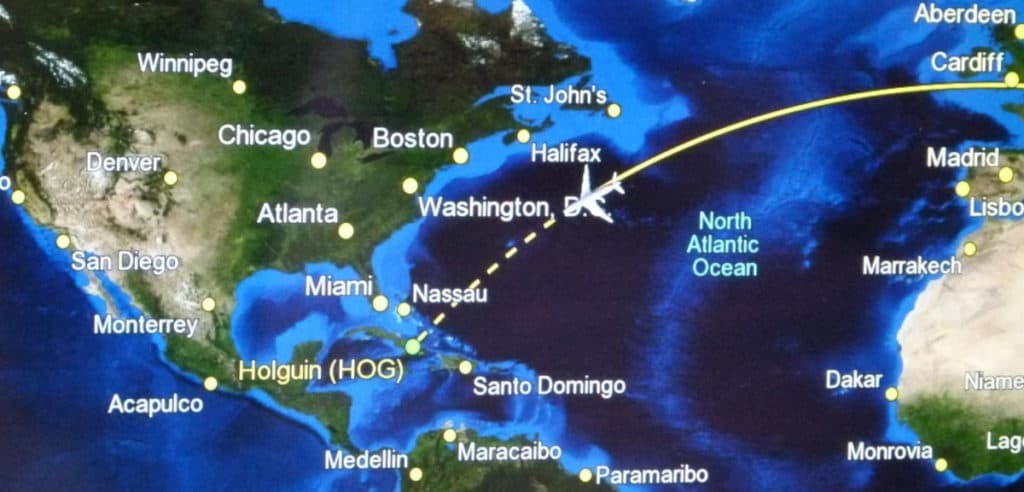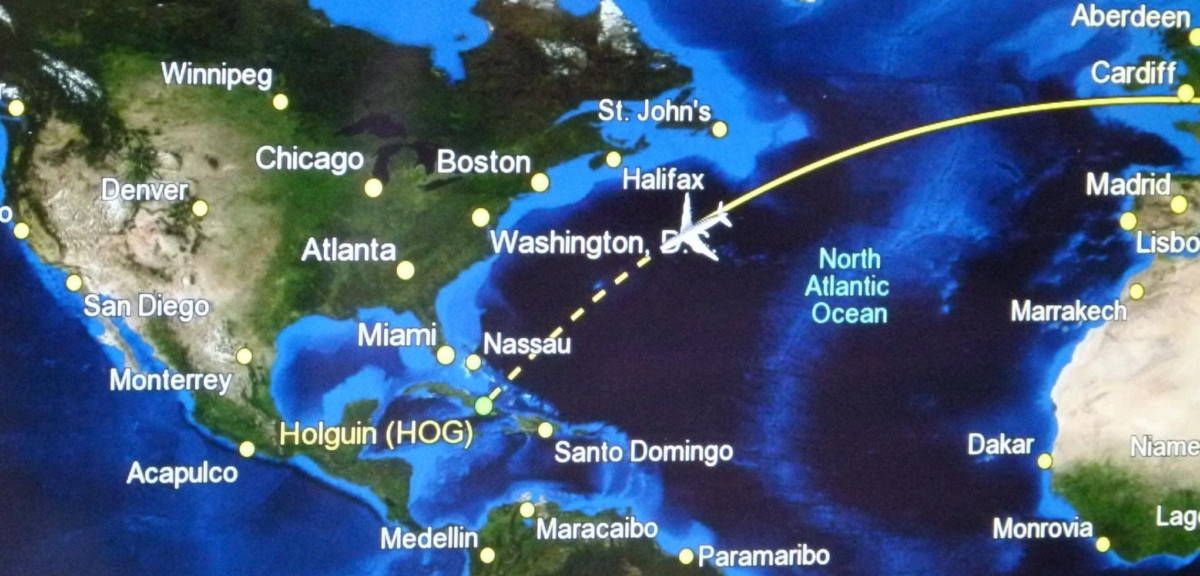
I enjoy looking at an interactive map as it’s a great way to see how much of the world I’ll be traveling over to get to my destination. What often confuses me is why an airplane’s route seems to take a curved path instead of a straight line. Surely a straight line is the most direct route, right?
Airplanes fly in a curve to get to their destination in the shortest time. A curved flight path accounts for the shape of the Earth and can look confusing on a two-dimensional map. Flying in a curved direction is calculated using the Great Circle Route and is also used in sailing.
Keep reading this article to learn how the great circle route works, why airplanes can’t always go the most direct path, and what factors affect this.
The Great Circle Route Allows Airplanes To Fly in a Curve
Imagine you’re flying from Madrid to New York. As you can see in the image below, the straight line shows the origin of the flight to the destination (which just so happens to track the 40° latitude line). The curved line above shows a typical flight path that an aircraft would take.
On a two-dimensional map, it appears that the straight line looks like the shortest distance. However, as you may know from your science classes, the Earth is a sphere, which makes calculating the shortest distance a little trickier.
Here are the same lines tracked on an image of the globe. When we consider the shape of the Earth, the straight line that previously looked like the shortest route looks a lot longer.
Two-dimensional maps of a three-dimensional shape will distort the image of a distance. So to calculate the shortest distance between two points of the Earth, great circles are used.
A great circle is a name given to the largest possible circle that can be drawn around a sphere. If we were to draw a great circle around the Earth, the logical place would be the equator, where the Earth is widest.
If you think about it, great circles can be drawn around any part of the Earth. We could draw a great circle that also joins Madrid and New York. Like this:
The great circle that connects Madrid and New York gives us two possible arcs that connect the two points; one that spans the majority of the Earth and one that gives us the shortest distance to the two cities.
Great circles allow flight planners to calculate the shortest and most direct route to a destination. Calculating the shortest route benefits the airline by spending less money on fuel and allowing more time for the aircraft to make multiple trips.
Learn More…
Try These Articles:
* How Do Airplanes Not Freeze In Flight?
* How Much Fuel Do Airplanes Carry? (With 15 Examples)
If you’re still not sure about the Great Circle Route, here’s a YouTube video of Captain Tom Ferguson giving his explanation:
Do Airplanes Always Fly the Most Direct Route?
The Great Circle Route gives us a good understanding of calculating the shortest distance between two points on the Earth. However, the direct route isn’t always possible when it comes to flight paths.
Airplanes can’t always fly the most direct route due to safety reasons. Planners must consider air traffic density, weather, proximity to nearby emergency airports, which can mean that taking a longer path is required. Although this is inconvenient, it’s necessary for the safety of their passengers.
Several reasons prevent airplanes from taking the most direct route, such as air traffic, jet streams and winds, and so on. The following explains these reasons in more detail:

Join My Newsletter & Get Great Tips, Information and Experiences To Help You Become a Superb Pilot!
Air Traffic Is Managed Into Highways
According to the FAA, there can be 5,400 aircraft in the sky at peak operational times. Air space is separated into corridors to ensure a safe environment for thousands of passengers traveling.
Air traffic controllers are responsible for monitoring the air traffic in these corridors. They’ll give clearance to airline pilots when a change of altitude or course is required to maintain a safe separation distance from other aircraft.
Corridors have a set route to regulate the flow and direction of the air traffic that passes through a specific region. An aircraft’s flight path must account for this routing, affecting how directly the approach is to its destination.
Airliners Will Evaluate the Jet Streams and Wind Conditions Before Flying
Jet streams are bands of powerful wind that blow from west to east, typically at around 80 to 140 mph (128–225 km/h).
Jet streams can be great for commercial airliners traveling East as it pushes them closer to their destination without burning any more fuel. However, they can be the source of significant delays to your journey if the aircraft is traveling west.
If jet streams are forecasted to reach a peak speed of 275 mph (442 kph), flight planners will reroute the aircraft to avoid the jet stream, usually taking a longer route. This is to prevent high-stress loads on the aircraft created by flying at a higher speed close to the aircraft’s designed maximum cruise speed.
The Size of an Airliner Can Impact Your Routing
You may have noticed that commercial aircraft come in all shapes and sizes. Aircraft like the Boeing 747 or Airbus A380 are built with four engines, and others like the Boeing 787 are built with two. The size of the airliner doesn’t make much difference to us as a passenger, but it could impact your routing.
Two-engine aircraft have to remain close to an airport capable of accepting them for landing in the event of an engine failure. The procedure is in place to prevent aircraft from having to make a landing on water.
Two-engine aircraft are still preferred for long-haul journeys because they’re much more fuel-efficient than their four-engine counterparts. However, the good news is that new models are engineered to fly further away from land, which means less impact on routing.
Conclusion
While the routing of an aircraft can look confusing on a two-dimensional map, it’s curved for a reason. A flight path is designed with the curvature of the Earth in mind and is calculated by using the Great Circle Route.
Although flight planners can calculate the most direct route, it doesn’t necessarily mean the aircraft can take it. Many factors can affect an aircraft’s routing, including:
- Keeping to air traffic highways and gaining clearance from air traffic control
- Jet streams and winds
- Keeping in proximity with available airports


